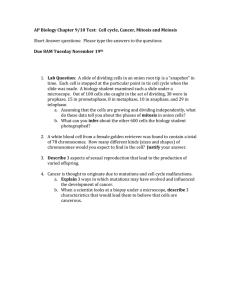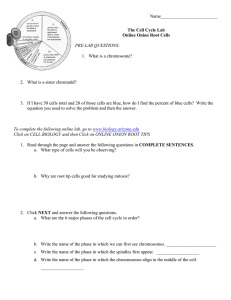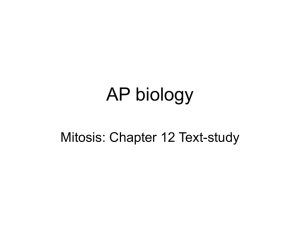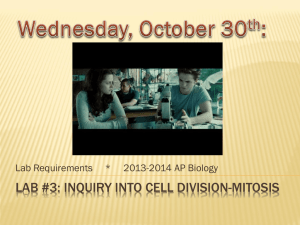UNIT 1 Timing Recommended Prior Knowledge
advertisement
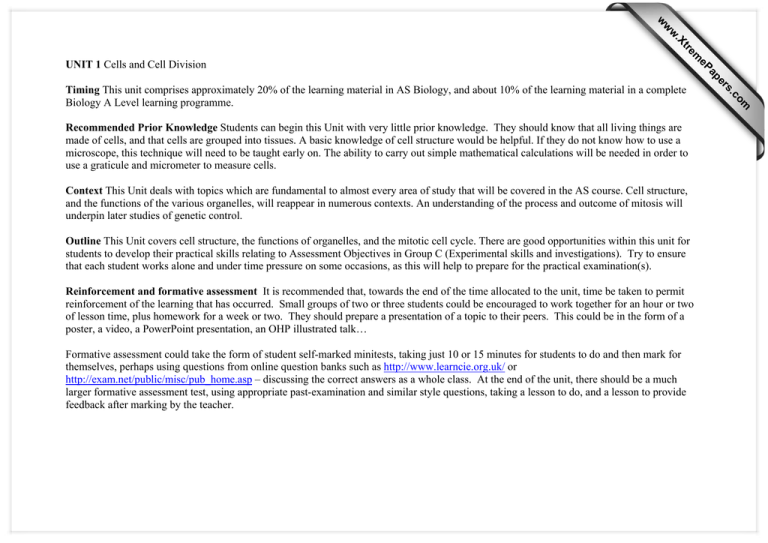
Context This Unit deals with topics which are fundamental to almost every area of study that will be covered in the AS course. Cell structure, and the functions of the various organelles, will reappear in numerous contexts. An understanding of the process and outcome of mitosis will underpin later studies of genetic control. Outline This Unit covers cell structure, the functions of organelles, and the mitotic cell cycle. There are good opportunities within this unit for students to develop their practical skills relating to Assessment Objectives in Group C (Experimental skills and investigations). Try to ensure that each student works alone and under time pressure on some occasions, as this will help to prepare for the practical examination(s). Reinforcement and formative assessment It is recommended that, towards the end of the time allocated to the unit, time be taken to permit reinforcement of the learning that has occurred. Small groups of two or three students could be encouraged to work together for an hour or two of lesson time, plus homework for a week or two. They should prepare a presentation of a topic to their peers. This could be in the form of a poster, a video, a PowerPoint presentation, an OHP illustrated talk… Formative assessment could take the form of student self-marked minitests, taking just 10 or 15 minutes for students to do and then mark for themselves, perhaps using questions from online question banks such as http://www.learncie.org.uk/ or http://exam.net/public/misc/pub_home.asp – discussing the correct answers as a whole class. At the end of the unit, there should be a much larger formative assessment test, using appropriate past-examination and similar style questions, taking a lesson to do, and a lesson to provide feedback after marking by the teacher. om .c Recommended Prior Knowledge Students can begin this Unit with very little prior knowledge. They should know that all living things are made of cells, and that cells are grouped into tissues. A basic knowledge of cell structure would be helpful. If they do not know how to use a microscope, this technique will need to be taught early on. The ability to carry out simple mathematical calculations will be needed in order to use a graticule and micrometer to measure cells. s er ap Timing This unit comprises approximately 20% of the learning material in AS Biology, and about 10% of the learning material in a complete Biology A Level learning programme. eP m e tr .X w w w UNIT 1 Cells and Cell Division A(f) Learning Outcomes draw plan diagrams of tissues (including a transverse section of a dicotyledonous leaf) Learning activities - - - - drawing leaf tissues and cells from photomicrographs or the CIE Bioscope practising the use of the microscope with a range of prepared leaf slides and fresh materials (e.g. Elodea sp. leaf) drawing tissues and cells from prepared slides showing plant leaves reinforce this by group presentation to peers – one group to choose this topic Suggested Teaching Activities Drawing a TS of a leaf can make a good introduction to the use of a microscope, and the calculation of magnification of drawings made from microscope slides. Students will need to be shown (or reminded) how to use a microscope. It is often a good idea to allocate each student, or pair of students, a particular microscope that they will always use. Remind them of leaf structure, and teach them how to draw a low power plan (that is, showing distribution of tissues but not details of individual cells). You may need to remind them of the meaning of the term 'tissue'. If you have a video camera that can be attached to a microscope, you can show them what they will see and describe how to draw it. Online Resources CIE Bioscope Lots of University Department and microscope manufacturer websites have wide collections of photomicrographs that students will find interesting e.g. http://micro.magnet.fsu.ed u/index.html Other resources Biology, Jones, Fosbery , Taylor and Gregory, shows an example of a photomicrograph of TS leaf and a plan diagram made from it. Comprehensive Practical Biology, Siddiqui, has information on how to use a microscope and how to draw plan diagrams. Biofactsheet 75: Microscopes and their uses in Biology A(f) (a) Learning Outcomes calculate the linear magnification of drawings; use a graticule and stage micrometer to measure cells and be familiar with units (millimetre, micrometre, nanometre) used in cell studies Learning activities - - - use CIE Bioscope to learn the principles of use of stage micrometer and eyepiece graticule use stage micrometer (expensive, but only one required) and eyepiece graticules fitted permanently into the eyepiece of the microscope to measure a range of microscopic objects calculate magnifications reinforce this by group presentation to peers – one group to choose this topic Suggested Teaching Activities Explain how to use a stage micrometer to calibrate an eyepiece graticule. If students always use the same microscope, then they can do this once for each objective lens, and keep a record of it. This means that they do not have to use the stage micrometer again, which is advantageous as it saves time, and also cost - stage micrometers are very expensive! Students can then use their calibrated eyepieces to measure the actual length of a part of the leaf on the slide. If they then measure the length that they have drawn on their diagram, they can calculate the linear magnification of their drawing. Online Resources http://www.philipharris.co. uk/ Philip Harris have very cheap micrometer graticules printed on transparent film, which you can cut out and use as eyepiece graticules CIE Bioscope Other resources Practical Advanced Biology, King et al, and Comprehensive Practical Biology, Siddiqui, have helpful information about calibrating a graticule and using it to measure cells. Advanced Biology principles and applications. Study Guide Clegg and Mackean also has a useful procedure to follow. Biology, Jones, Fosbery , Taylor and Gregory, clearly explains the use of a graticule. Learning Outcomes A(b) explain and distinguish between resolution and magnification, with reference to light microscopy and electron microscopy Learning activities - - verbal question and answer / class discussion comparison of photomicrographs with electron micrographs reinforce this by group presentation to peers – one group to choose this topic Suggested Teaching Activities Revise the meaning of the term ‘magnification’ – you can do this with reference to the calculation students have made of the linear magnification of their leaf drawing. Introduce the term ‘resolution’ – many teachers find that referring to newspaper pictures (made up of quite large and visible dots) and better quality photographs (where no dots are visible) is helpful here. Explain briefly how light microscopes and electron microscopes work – but do not be tempted to go into more detail than needed – and use this to explain why resolution of electron microscopes is much greater than that of light microscopes. Online Resources http://www.biology4all.co m/resources_library/62.asp Light micrographs of cheek cells and plant cells, which could be used to contrast with electron micrographs, or be used for calculating magnification. Other resources Advanced Biology, Jones and Jones, CUP, uses photographs to explain the difference between magnification and resolution. Biology, Jones, Fosbery , Taylor and Gregory, has light and electron microscope photographs of the same cell at the same magnification, illustrating the differences in resolution. Learning Outcomes A(c) describe and interpret drawings and (d) photographs of typical animal and plant cells, as seen under the electron microscope, recognising the following membrane systems and organelles - rough and smooth endoplasmic reticula, Golgi apparatus, mitochondria, ribosomes, lysosomes, chloroplasts, plasma/cell surface membrane, nuclear envelope, centrioles, nucleus and nucleolus outline the functions of the membrane systems and organelles listed (c) Learning activities - - question and answer / whole class discussion of structure and function of organelles examine electron micrographs and identify organelles reinforce this by group presentation to peers – one group to choose from each of a range of organelles Suggested Teaching Activities Using diagrams and photographs, discuss the structures and functions of each organelle in turn. Remember that students will know virtually no molecular biology at this stage, so do not go into too much detail if this is likely to confuse. Present students with electron micrographs, and ask them to identify particular structures and organelles on them. Online Resources http://www.rothamsted.bbs rc.ac.uk/notebook/index.ht ml Information and links to various sites useful for AS students, covering most aspects of cell biology; there is also a CD ROM Molecular Biology Notebook, which can be ordered online from this web site. http://web.mit.edu/esgbio/ www/cb/organelles.html Information, diagrams and excellent electron micrographs of cells and organelles. Other resources Biofactsheet 4: Structure and function in eukaryotic cell Biology, Jones, Fosbery , Taylor and Gregory, has a variety of useful photomicrographs electronmicrographs and diagrams Learning Outcomes A(e) describe the structure of a prokaryotic cell and compare and contrast the structure of prokaryotic cells with eukaryotic cells Learning Activities - - - draw diagrams and tabulate lists of the main similarities and differences between prokaryotes and eukaryotes summarise these differences into a few bullet points examine photomicrographs and electron micrographs selected to emphasise the similarities and differences reinforce this by group presentation to peers – one group to choose this topic Suggested Teaching Activities Show students photographs and diagrams of typical prokaryotic cells. Discuss with them the major differences between them and eukaryotic (plant and animal) cells. Ask students to make a summary of these differences. (You may like to make particular reference to the bacteria responsible for cholera and TB, as these will be referred to in Unit 5.) Online Resources Other resources http://www.biology4all.co Biofactsheet 73: The m/resources_library/68.asp prokaryotic cell A Flash animation about prokaryotes and eukaryotes Biology, Jones, Fosbery , Taylor and Gregory, clearly contrasts prokaryotic and eukaryotic cells E(a) (b) Learning Outcomes explain the importance of mitosis in growth, repair and asexual reproduction; explain the need for the production of genetically identical cells and fine control of replication Suggested Teaching Activities Discuss with students how their own growth occurs, involving the growth and division of cells. Online Resources http://www.teachingbiomed.man.ac.uk/ramsay/ Overv.htm offers an opportunity for teachers Remind students that the nucleus and interested students to contains chromosomes. Explain to them understand the underlying that each chromosome is a length of processes of mitosis Learning Activities DNA, which carries a set of instructions for the cell. (It is suggested http://www.sciencecases.o - verbal question and answer / that you do not go into any further rg/mitosis_meiosis/mitosis whole class discussion detail at this stage.) Bring out the idea _meiosis_notes.asp is an - brief written explanation of the that, when a cell divides, it is essential interesting way of biological importance of mitosis, that each new cell obtains a complete approaching mitosis (and from bibliographic and webset of these instructions. Explain that meiosis) as a ‘court case’. based research cell division which achieves this is called mitosis. Emphasise that the cells produced by mitosis are genetically identical. Consider some simple examples where reproduction occurs by processes based on mitosis, for example Hydra, or a locally available plant that reproduces asexually. Other resources Biology, Jones, Fosbery , Taylor and Gregory has a section on the biological significance of mitosis.. (d) Learning Outcomes describe, with the aid of diagrams, the behaviour of chromosomes during the mitotic cell cycle and the associated behaviour of the nuclear envelope, cell membrane, centrioles and spindle (names of the main stages are expected) Learning activities - - - - - - correctly sequence photocopies of plant and animal photomicrographs (originating in books and websites) make annotated diagrams of the key events in mitosis prepare garlic or onion root tips, stain with acetic orcein and squash under a coverslip examine these squashes, prepared slides of plant root tips, and CIE Bioscope slides for cells at all stages of mitosis. draw cells at high power to show the appearance of the chromosomes and cell wall at various stages of mitosis use the eyepiece graticule to measure the relative length and width of chromosomes and cells. use the calibrated eyepiece graticule to measure the size of chromosomes in µm Suggested Teaching Activities Set up a demonstration of a ‘model’ on a desk or OHP of a diploid cell with 4 chromosomes – using string from the cell and nuclear membrane, and 2 short and 2 long pipe cleaners for the chromosomes. Demonstrate need for replication before mitosis by twisting a second pipe cleaner around the first, to give 8 pipe cleaners in the nucleus, explaining that each pipe cleaner is a chromatid, and that each chromosome is now made up of two identical chromatids. Facilitate whole class discussion / question and answer to build understanding of how the chromosomes line up and how the chromatids of each chromosome separate to each end of the cell, why the nuclear envelope breaks down (to make room for movement of chromosomes) and why nuclear division takes place before cell division. Provide prepared slides of plant root tips, and CIE Bioscope slides for cells at all stages of mitosis. Use the calibrated eyepiece graticule to measure the size of chromosomes in µm Online Resources http://www.bbc.co.uk/educ ation/asguru/biology/04ge nesgenetics/02replication mitosis/index.shtml The BBC AS Guru site has a simple animation of mitosis. http://www.rothamsted.bbs rc.ac.uk/notebook/courses/ guide/movie/mitosis.htm Another mitosis animation. http://wwwsaps.plantsci.cam.ac.uk/wo rksheets/ssheets/ssheet17.h tm A very clear protocol for making a root tip squash. http://faculty.nl.edu/jste/mi tosis.htm A series of diagrams, animations and text explaining mitosis. University of Arizona web site has animations of mitosis and on-line tests. http://www.biology.arizon a.edu/cell_bio/tutorials/cel l_cycle/main.html Other resources Both Practical Advanced Biology, King et al and Comprehensive Practical Biology, Siddiqui, have protocols for observing mitosis in root tips. Biofactsheet 76: The eukaryotic cell cycle and mitosis Biology, Jones, Fosbery , Taylor and Gregory has a chapter on nuclear division. E(c) Learning Outcomes explain how uncontrolled cell division can result in cancer and identify factors that can increase the chances of cancerous growth Learning activities - whole class discussion bibliographic and web-based research individual brief written explanations of the origin, potential causal agents and impact of cancer Suggested Teaching Activities This topic is best dealt with by discussion. The timing of cell division is controlled by a number of genes; if several of these are altered then the cell may begin to divide uncontrollably. This may happen naturally, but the risk is increased by a range of different environmental factors. Students may be interested in international statistics of the frequency of different types of cancer around the world. Online Resources http://www3.who.int/whos is/mort/table1.cfm?path=w hosis,mort,mort_table1&la nguage=english The World Health Organisation web site with data tables for causes of mortality in many different countries, which students could use to practise data handling as well as investigating the occurrence of deaths from cancers. Other resources Biofactsheet 104: Biological basis of cancer Biology, Jones, Fosbery , Taylor and Gregory has a section on cancer. E(e) Learning Outcomes explain the meanings of the terms haploid and diploid and the need for a reduction division prior to fertilisation in sexual reproduction Learning activities - verbal question and answer / whole class discussion production of individual explanatory annotated diagrams Suggested Teaching Activities The pipe cleaner model may be useful again here. A haploid cell has one complete set of chromosomes, whereas a diploid cell has two complete sets. Students usually have no difficulty in understanding the need for reduction division before fertilisation. Do NOT go into any details of meiosis here indeed, not even its name need be mentioned. Online Resources http://www.accessexcellen ce.org/AB/GG/hapDIP.ht ml has a nice OHP picture http://courses.washington. edu/luca201/05_14_01.pdf The first five pages of this pdf are a nice series of explanatory pictures Other resources Biology, Jones, Fosbery , Taylor and Gregory explains these concepts at an appropriate level.
